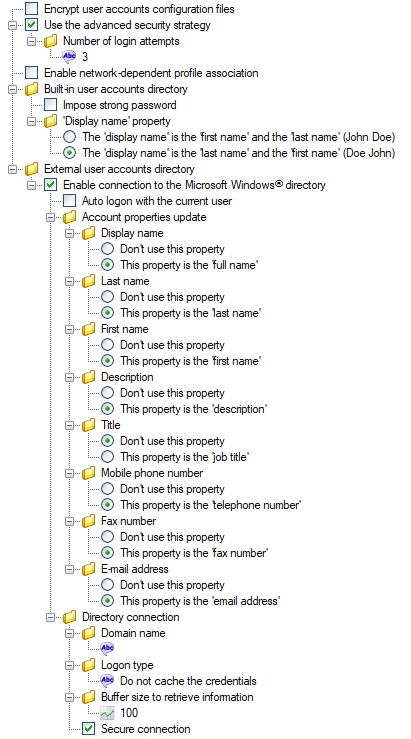User Accounts Settings
The User Accounts settings are displayed from the Settings task when the User Accounts folder is selected in the Application Explorer's configuration tree. ![]() Show picture
Show picture
- Encrypt user accounts configuration file - Encrypt the User Accounts configuration file so that it cannot be read with a text editor.
- Use the advanced security strategy - See the topic What is the Advanced Security Strategy for more information.
- Number of login attempts - The number of login attempts before an account is locked. Range 1 to 10. Default 3.
- Enable networking-dependent profile association - Enable User Accounts to use different profiles depending on which station the account is being used.
- Built-in user accounts directory
- Impose strong password - Force the use of a strong password. See the topic Choosing a Strong Password for more information.
- 'Display name' property - Select the manner in which the Display Name is constructed from the First Name and Last name properties.
- External user accounts directory
- Enable connection to the Microsoft Windows® directory - Enable the configuration of user accounts using Windows User Group users. See the topic Using Windows Domain User Groups for more information.
- Auto logon with current user - If activated, the current Windows user is automatically logged in to PcVue at startup if it is allowed to (matching Windows user groups/profile). If it is not, the login dialog box is displayed.
- Account properties update
- Display name - use the Full Name property from the external user account as PcVue Display Name property.
- Description - Use the Description property from the external user account as PcVue Description property.
- Title - Use the Job title property from the external user account as PcVue Title property.
- Mobile phone number - Use the Telephone number property from the external user account as PcVue Mobile phone number property.
- E-mail address - Use the Email address property from the external user account as PcVue E-mail address property.
- Directory connection
- Domain name - Allow authentication of Users on a specific domain.
Defaults to empty to indicate that users should be authenticated against the domain to which the computer belongs.
Set a value corresponding to a domain name if you need users to be authenticated against another specific domain. - Domain controller name - For large networks the domain can have several controllers. This setting allows the selection of a specific controller (normally the fastest). In some projects, this can bring significant performance improvements.
Defaults to empty to indicate that the first available Domain Controller will be used.
Set a value corresponding to a Domain Controller name if you need the authentication feature to rely on a specific Domain Controller. - Logon type - Depending on the security strategy of the domain, some logon types do not work. Do not cache the credentials requires a weaker strategy than Cache the credentials.
Cache the credentials, when allowed by the domain, allows a User to logon to a computer, if he had already done so in the past, even if the controller is not accessible (LOGON32_LOGON_INTERACTIVE).
Do not cache credentials is intended for high performance servers to authenticate with plaintext passwords and does not cache credentials (LOGON32_LOGON_NETWORK). - Buffer size to retrieve information - The size of the buffer used to retrieve the configuration of the domain controller (list of user groups...). When a large number of user groups are declared in the domain controller, increasing the value of this property can help to improve performance if the Domain Controller is set accordingly. Range 1 to 1000 - Defaults to 100.
Secure connection - Enabled by default. Disable this setting if your AD-FS deployment does not include the use of a certificate for securing connection to the AD-FS server when browsing groups using LDAPS services.
- Domain name - Allow authentication of Users on a specific domain.
If the Domain controller name is left empty, PcVue will use the first accessible domain controller as evaluated by the local Windows host operating system.
